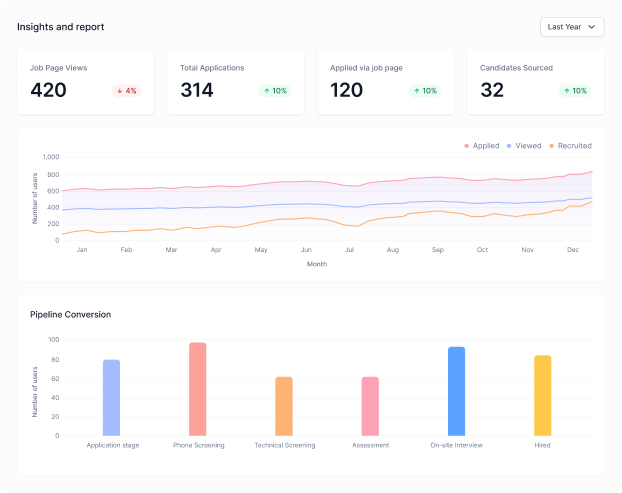Retaining top employees is one of the most critical challenges companies face today. According to the 2024 Work Trend Index Annual Report by Microsoft and LinkedIn, 46% of employees are considering quitting their jobs. This leaves companies and CEOs with the tough task of creating effective employee retention strategies.
As your organization grows, reducing employee retention strategies becomes important — not only to reduce turnover rates but also to help you maintain productivity and ensure long-term business success. Replacing a single employee is expensive, with several studies estimating it to cost between one-half to two times the employee’s annual salary. It is, therefore, imperative for companies and businesses to invest in strategies that keep their top talent engaged and loyal.
In this article, we’ll explore five proven strategies that will help you keep your best employees and create a positive, thriving work environment for them.
Foster a Positive Workplace Culture
Workplace culture is one of the most important drivers of employee retention. Employees who feel connected to their company’s mission and values are more likely to stay. A strong workplace culture fosters trust, collaboration, and engagement, all of which contribute to a positive work environment. When employees are part of a culture that supports them both personally and professionally, they are less likely to seek new opportunities elsewhere.
How to Implement
RHow to Implement:
- Promote open communication: Encourage an environment where employees feel comfortable sharing their thoughts and feedback. Transparent communication builds trust and keeps employees engaged.
- Recognize achievements: Regularly acknowledge and reward employees for their hard work and contributions. Public recognition boosts morale and makes employees feel valued.
- Encourage collaboration: Build a team-oriented culture that values diverse perspectives and encourages teamwork across all levels.
Companies with strong workplace cultures, like Salesforce and Zappos, have successfully retained top talent by focusing on creating environments where employees feel appreciated, supported, and aligned with the company’s goals.
Offer Competitive Compensation and Benefits
Offering competitive compensation is a foundational strategy for retaining your best employees. Compensation isn’t just about salary; it includes the entire benefits package, such as health insurance, retirement plans, and flexible work arrangements. When employees feel they are fairly compensated for their contributions, they are less likely to look elsewhere.
How to Implement
- Benchmark salaries regularly: Ensure your compensation packages remain competitive by comparing them to industry standards and making adjustments as needed.
- Provide flexible benefits: Offer benefits that reflect the diverse needs of your employees, such as healthcare, wellness programs, and remote work options.
- Invest in financial wellness: Provide resources that help employees manage their finances, such as retirement planning tools and financial counseling services.
By offering competitive compensation and comprehensive benefits, companies like Google have been able to retain top talent and maintain a motivated, loyal workforce.
Prioritize Career Development and Growth Opportunities
A lack of career growth is one of the most common reasons employees leave a company. Employees want to feel like they have opportunities to advance within their organization. Career development not only keeps employees engaged but also prepares them to take on more senior roles, reducing turnover and saving the company from the high costs of hiring externally.
How to Implement
- Create clear career paths: Make sure employees know what opportunities are available to them and how they can work toward promotions and new roles within the company.
- Offer professional development programs: Provide ongoing training, certifications, and opportunities for learning to help employees develop new skills and advance in their careers.
- Encourage mentorship: Establish mentorship programs that connect junior employees with senior leaders who can offer guidance and career advice.
At LinkedIn, employees are encouraged to pursue different roles and projects within the company. This internal mobility helps retain employees by providing them with a sense of growth and long-term career development.
Support Work-Life Balance
Work-life balance has become a top priority for employees, especially with the rise of remote and hybrid work models. Employees who feel overworked or unable to balance personal and professional responsibilities are at a higher risk of burnout, which often leads to turnover. Companies that prioritize work-life balance not only improve employee satisfaction but also retain top talent by showing that they value their employees’ well-being.
How to Implement
- Offer flexible work arrangements: Allow employees to adjust their schedules or work from home when needed. This flexibility helps reduce stress and boosts job satisfaction.
- Promote time off: Encourage employees to take vacations and breaks to recharge, reducing the risk of burnout.
- Support mental health: Offer wellness programs, mental health days, and access to counseling services to help employees manage stress and stay productive.
At Buffer, the company’s commitment to work-life balance through flexible schedules and remote work options has helped it build a strong, loyal workforce, making it easier to retain employees over the long term.
Build Strong Leadership and Communication
Strong leadership is essential to retaining employees. Studies show that many employees leave their jobs due to poor management or lack of communication with their supervisors. Employees who feel supported and heard by their managers are more likely to stay engaged and committed to their work. Effective leadership builds trust, fosters open communication, and motivates employees to perform at their best.
How to Implement
- Train managers on leadership skills: Provide leadership training programs focused on communication, empathy, and conflict resolution to ensure managers are prepared to lead their teams effectively.
- Encourage transparency: Leaders should openly communicate company goals, challenges, and achievements with their teams. This transparency builds trust and fosters a sense of belonging.
- Establish mentorship programs: Connect employees with mentors within the organization who can offer guidance, career advice, and support.
At Patagonia, strong leadership and open communication have helped build a culture of trust, loyalty, and engagement, making it easier to retain employees who feel valued by their leaders.
Conclusion
Retaining top talent is essential to the success of any organization. By implementing these employee retention strategies, your company can significantly reduce employee turnover and keep your best employees engaged.
In today’s competitive job market, employee retention is more important than ever. Investing in your employees’ satisfaction and well-being will not only help retain top talent but also create a work environment where employees feel motivated to contribute to the company’s long-term success.






